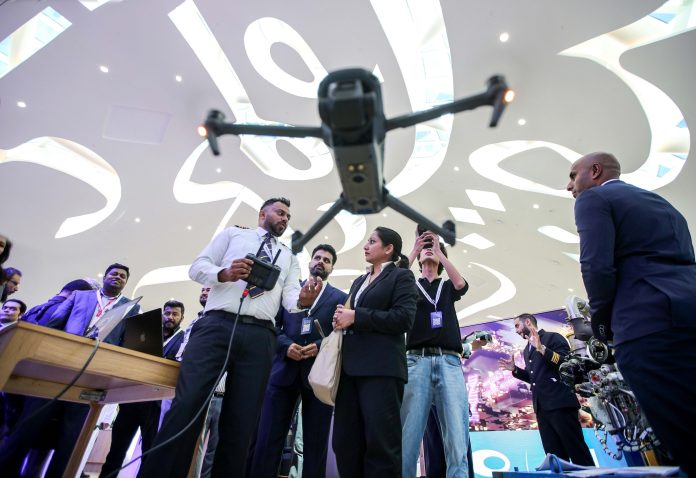Aviation Future Week (AFW), organised by Emirates Airline and the Museum of the Future concluded today, bringing together key leaders in aviation and aerospace, airfreight, Maintenance, Overhaul & Repair (MRO) and logistics. The event’s progressive programme also included experts and academics working closely to develop breakthrough strategies and viable aviation-focused use cases in XR and Gen AI.
Taking place at the Museum of the Future, the event served as a showcase for futuristic products, capturing the latest innovations in onboard products, leveraging improvements in maintenance operations, and supporting seamless journeys on the ground.
Adel Al Redha, Deputy President and Chief Operations Officer, Emirates said: “With a rich programme and a display of remarkable technologies and game-changing solutions, the last three days have forged transformative discussions that will help deliver real impact and contribute to the industry’s progress across a gamut of pressing issues. By being open to different perspectives, we can all acknowledge where the real challenges are, and where innovation and embracing technologies can truly make a difference.”
The final day of the event looked ahead to the future potential of Web3, AI and XR to drive better customer experiences and enhance aviation workflows.
Frank Meyer, Chief Digital Officer of Etihad Airways set the scene with an opening keynote focusing on how advancements in computing power, data analytics, and machine learning are revolutionizing the airline industry.
According to Meyer, airlines can overcome legacy systems enhance the customer experience through personalization and automation, improve operational efficiency by streamlining processes, optimize inventory and asset management with predictive technologies, and ensure reliability in air travel timing. The ultimate goal is to create a more resilient, agile business that delivers tangible benefits to both the company and its employees.
Following that, a panel around ‘Leveraging Automated Feedback to Transform Customer Experience’ featuring Dr. Nejib Ben Khedher, Divisional Senior Vice President Emirates Skywards; Frank Meyer, Chief Digital Officer of Etihad Airways; Miguel Leitmann, Chief Executive Officer of Vision-Box and Dr. Nils Lukas, Assistant Professor at Mohamed bin Zayed University of Artificial Intelligence, discussed the latest advancements in AI-powered feedback collection and analysis, and how businesses can use these insights to drive improvements in products, services, and overall customer satisfaction.
Experts emphasized the importance of data-sharing among stakeholders, such as airlines, airports, and government agencies, and the need for collaboration between academia and industry to harness the full potential of AI.
Leitmann highlighted the transformative impact of AI and machine learning (ML) on airport operations, with Emirates as a well-known use-case.
Dr. Lukas noted: “As AI models evolve, maintaining confidentiality and minimising algorithmic bias are key challenges,” Lukas noted. “We are researching technologies like differential privacy and homomorphic encryption to reduce privacy risks while maintaining model accuracy.”
The final panel, titled ‘Combining the Power of XR and Gen AI to Revolutionise Aviation Workflows’ explored how extended reality (XR) and generative AI can be combined to enhance training, improve operational efficiency, and create new opportunities for innovation. The session featured Timothy Jung, Chair Professor at Manchester Metropolitan University; Tariq Halawani, Executive Director at Microsoft Solutions in the UAE; Stephan Muller, GCC Director at Whoop; and Amira Al Awadhi, Senior Vice President for HR Operations and Systems at Emirates.
Participants agreed that the combination of XR and generative AI offers enormous opportunities to improve quality of life and increase workforce productivity. Timothy Jung, Chair Professor of XR at Manchester Metropolitan University, emphasized how advanced technologies can improve education and training programs, tailoring them to the future’s needs.
Jung said: “With the help of Gen AI and big data, training can be tailored to the needs of each individual. Personalised training means that the content, pace, and style of learning can be adjusted based on the learner’s preferences and performance, making the training more effective and efficient.”
Tariq Halawani, Executive Director of Enterprise Solutions at Microsoft UAE, likened adopting new technology to cultural change, and said Microsoft is on a learning curve with its customers. “This ongoing learning cycle is crucial for continuous improvement and innovation.”
Halawani added that AI tools should be accessible to all knowledge workers to maximise the benefits. Microsoft has seen a 10-12% increase in productivity among employees who use advanced technology.
According to Stephan Muller, Director of GCC at Whoop, wearable technology can have a transformative effect on team performance. “Metrics like sleep, strain and recovery can illuminate what wearers are experiencing, enabling companies to create wellness routines accordingly.”
In addition to the riveting sessions, participants at the three-day event explored exhibits and technologies that have the potential to help power the commercial aviation industry in the future:
- Visitors to AFW tested the Biometric Tunnel, an enhanced barrier-free airport experience for travellers, enabled by advanced biometrics in partnership with Dubai’s General Directorate of Residency and Foreigner Affairs (GDRFA) and Dubai Airports.
- The Sign Language Robot, developed to specifically support hearing impaired travellers, using hand gestures to establish more efficient communication for check-in, wayfinding and answering general questions.
- The Emirates VR Experience is a future focused enhancement tailored for people of determination with the purpose of allaying their travel anxiety through experiencing airport touchpoints to familiarise themselves with the on ground journey including check-in, immigration, security checks, and other facilities.
- Panasonic and Thales showcased their next generation inflight entertainment systems, with rich display capabilities for more immersive experiences, including a plethora of multi-purpose connectivity options, personalisation features and more. The Thales display is a replica of what’s in store for the Emirates A350. Panasonic presented MAYA, which fuses physical and digital technologies for ultra-widescreen viewing, high-definition immersion and customisation as well as other functionalities not seen before in the industry.
- The Autonomous Drone Based Inspection showcase integrates the latest UAV technologies for a leap forward in exterior inspections, with ultra high-resolution cameras, unmatched precision, consistent output and deep insights providing data on every angle of the aircraft under maintenance.
- Augmented Reality maintenance technologies demonstrated how an x-ray view to investigate the innermost workings of any part of an aircraft and other intricacies helps to deliver more precise inspections, and significantly cut maintenance times.
- Touching on ways the industry is working to reduce waste and creatively repurpose aircraft components, ‘Aircrafted by Emirates’ – a unique capsule collection of luggage, bags and accessories – all fashioned from upcycled materials from retrofitted aircraft were on display.
Invitation-only workshops addressed a variety of topics, including: the customer journey 10 years from now; how aviation can make the transition to a low carbon future, while balancing growth, with a focus on the implications for the UAE; what Emirates Group customers expect from Al Maktoum International Airport for seamless, interconnected, world-class, and multi-modal (air, sea, rail) logistics operations; leveraging technology and AI to address key issues like airspace capacity management, flight-deck wellbeing, pilot training, retention and addressing pilot shortages; integrating ideas, initiatives, suggestions, and perspectives of youth into the organisation’s decision-making processes and challenging traditional hierarchies and overcoming limitations.








